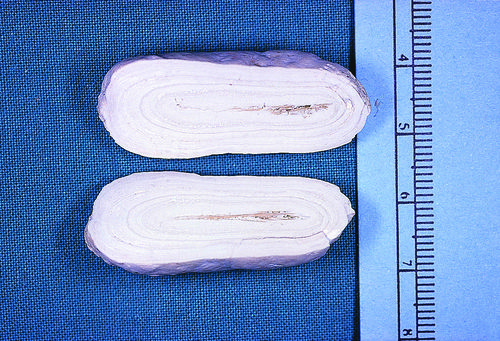Difference between revisions of "Veterinary Dentistry Q&A 08"
Ggaitskell (talk | contribs) |
|||
| (One intermediate revision by the same user not shown) | |||
| Line 1: | Line 1: | ||
| + | {{Template:Manson | ||
| + | |book = Veterinary Dentistry Q&A}} | ||
| + | |||
[[File:Vet Dentistry 08.jpg|centre|500px]] | [[File:Vet Dentistry 08.jpg|centre|500px]] | ||
| Line 11: | Line 14: | ||
|a1= | |a1= | ||
A sialolith. | A sialolith. | ||
| − | |l1= | + | |l1=Sialolithiasis |
|q2=What is the pathogenesis of this condition? | |q2=What is the pathogenesis of this condition? | ||
|a2= | |a2= | ||
| Line 21: | Line 24: | ||
A single, large sialolith located in a salivary duct may give rise to some retention of saliva but is generally believed not to cause a salivary mucocele. | A single, large sialolith located in a salivary duct may give rise to some retention of saliva but is generally believed not to cause a salivary mucocele. | ||
| − | |l2= | + | |l2=Sialolithiasis |
</FlashCard> | </FlashCard> | ||
Latest revision as of 13:15, 14 October 2011
| This question was provided by Manson Publishing as part of the OVAL Project. See more Veterinary Dentistry Q&A. |
This structure (which has been bisected) caused a palpable swelling over the maxilla of a horse and was subsequently surgically removed from the parotid salivary duct.
| Question | Answer | Article | |
| What is it? | A sialolith. |
Link to Article | |
| What is the pathogenesis of this condition? | An ascending foreign body, in this case a grass awn, is usually the cause of a single sialolith within a salivary duct. The sialolith consists of concentric layers of mostly calcium phosphate crystals around the organic nucleus. They are usually elongated in shape. In the dog and cat, dystrophic calcification of inspissated saliva in salivary mucoceles may also result in sialolith formation; in these cases, multiple small sialoliths may be present. A single, large sialolith located in a salivary duct may give rise to some retention of saliva but is generally believed not to cause a salivary mucocele. |
Link to Article | |
